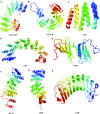Expansion and Function of Repeat Domain Proteins During Stress and Development in Plants
- PMID: 26793205
- PMCID: PMC4707873
- DOI: 10.3389/fpls.2015.01218
Expansion and Function of Repeat Domain Proteins During Stress and Development in Plants
Abstract
The recurrent repeats having conserved stretches of amino acids exists across all domains of life. Subsequent repetition of single sequence motif and the number and length of the minimal repeating motifs are essential characteristics innate to these proteins. The proteins with tandem peptide repeats are essential for providing surface to mediate protein-protein interactions for fundamental biological functions. Plants are enriched in tandem repeat containing proteins typically distributed into various families. This has been assumed that the occurrence of multigene repeats families in plants enable them to cope up with adverse environmental conditions and allow them to rapidly acclimatize to these conditions. The evolution, structure, and function of repeat proteins have been studied in all kingdoms of life. The presence of repeat proteins is particularly profuse in multicellular organisms in comparison to prokaryotes. The precipitous expansion of repeat proteins in plants is presumed to be through internal tandem duplications. Several repeat protein gene families have been identified in plants. Such as Armadillo (ARM), Ankyrin (ANK), HEAT, Kelch-like repeats, Tetratricopeptide (TPR), Leucine rich repeats (LRR), WD40, and Pentatricopeptide repeats (PPR). The structure and functions of these repeat proteins have been extensively studied in plants suggesting a critical role of these repeating peptides in plant cell physiology, stress and development. In this review, we illustrate the structural, functional, and evolutionary prospects of prolific repeat proteins in plants.
Keywords: ANK; Armadillo; HEAT; PPR; TPR; WD40; abiotic stress; tandem repeat.
Figures

Similar articles
-
Transcriptome-wide Identification of Nine Tandem Repeat Protein Families in Roselle (Hibiscus sabdariffa L.).Trop Life Sci Res. 2024 Oct;35(3):121-148. doi: 10.21315/tlsr2024.35.3.6. Epub 2024 Oct 7. Trop Life Sci Res. 2024. PMID: 39464663 Free PMC article.
-
Tandem-repeat protein domains across the tree of life.PeerJ. 2015 Jan 13;3:e732. doi: 10.7717/peerj.732. eCollection 2015. PeerJ. 2015. PMID: 25653910 Free PMC article.
-
Protein repeats: structures, functions, and evolution.J Struct Biol. 2001 May-Jun;134(2-3):117-31. doi: 10.1006/jsbi.2001.4392. J Struct Biol. 2001. PMID: 11551174 Review.
-
An Analytical Review of the Structural Features of Pentatricopeptide Repeats: Strategic Amino Acids, Repeat Arrangements and Superhelical Architecture.Int J Mol Sci. 2021 May 20;22(10):5407. doi: 10.3390/ijms22105407. Int J Mol Sci. 2021. PMID: 34065603 Free PMC article. Review.
-
Molecular phylogeny of the kelch-repeat superfamily reveals an expansion of BTB/kelch proteins in animals.BMC Bioinformatics. 2003 Sep 17;4:42. doi: 10.1186/1471-2105-4-42. Epub 2003 Sep 17. BMC Bioinformatics. 2003. PMID: 13678422 Free PMC article.
Cited by
-
Genome-Wide Association Study Reveals Genomic Regions Associated with Fusarium Wilt Resistance in Common Bean.Genes (Basel). 2021 May 18;12(5):765. doi: 10.3390/genes12050765. Genes (Basel). 2021. PMID: 34069884 Free PMC article.
-
Systematic analysis of CCCH zinc finger family in Brassica napus showed that BnRR-TZFs are involved in stress resistance.BMC Plant Biol. 2021 Nov 23;21(1):555. doi: 10.1186/s12870-021-03340-8. BMC Plant Biol. 2021. PMID: 34814855 Free PMC article.
-
Genome sequencing of turmeric provides evolutionary insights into its medicinal properties.Commun Biol. 2021 Oct 15;4(1):1193. doi: 10.1038/s42003-021-02720-y. Commun Biol. 2021. PMID: 34654884 Free PMC article.
-
Computational Characterization of the mtORF of Pocilloporid Corals: Insights into Protein Structure and Function in Stylophora Lineages from Contrasting Environments.Genes (Basel). 2019 Apr 27;10(5):324. doi: 10.3390/genes10050324. Genes (Basel). 2019. PMID: 31035578 Free PMC article.
-
The number of genes encoding repeat domain-containing proteins positively correlates with genome size in amoebal giant viruses.Virus Evol. 2018 Jan 3;4(1):vex039. doi: 10.1093/ve/vex039. eCollection 2018 Jan. Virus Evol. 2018. PMID: 29308275 Free PMC article.
References
-
- Acosta M. G., Ahumada M. A., Lassaga S. L., Casco V. H. (2012). PUB16 gene expression under abiotic stress and their putative role as an ARM repeat protein in Arabidopsis thaliana self-pollination pathway. Adv. Biosci. Biotechnol. 3 609–619. 10.4236/abb.2012.35079 - DOI
Publication types
LinkOut - more resources
Full Text Sources
Other Literature Sources

